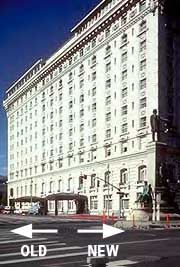
|
A new addition (right) that is an exact replica of the historic building (left) and cannot be distinguished from it, diminishes the historic character of the original building. Thus, this is not a compatible treatment. Photo: Richard Wagner |
The Standards for Rehabilitation
To help owners and developers select work approaches that will meet the Secretary of the Interior’s Standards for Rehabilitation, helpful guidance is provided in this section for some of the especially problematic treatments for the exteriors and interiors of historic buildings. Historic Building Exterior Historic Building Interior
Note: Because each historic building comprises a unique set of circumstances (significance, condition, setting, and use), the guidance for each topic is, of necessity, general in nature. The specific work selected to bring a rehabilitation project into conformance with the Standards may vary. Each rehabilitation project is reviewed on a case-by-case basis. |
|
